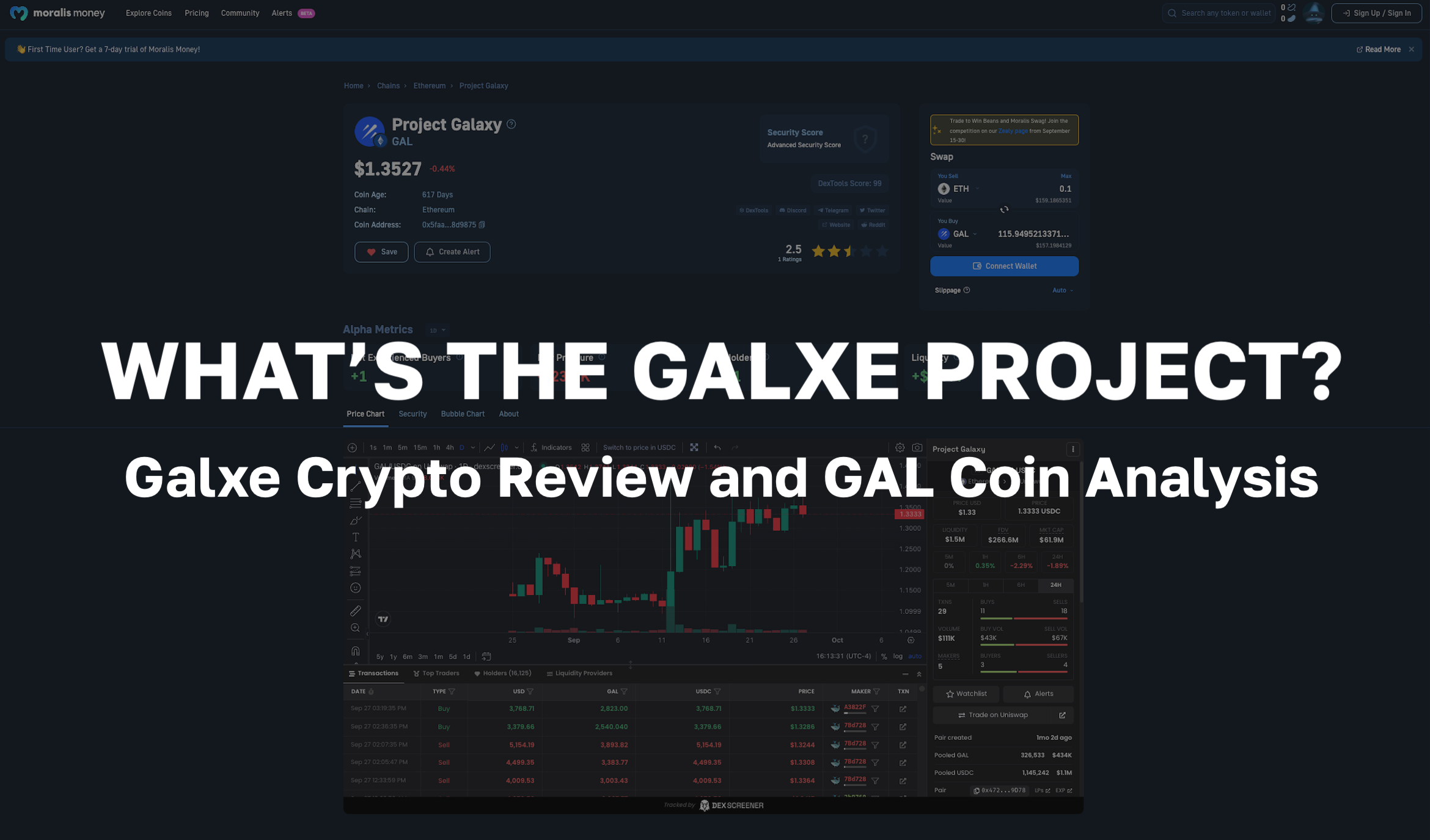In this article, we compare and distinguish the elements of active investing vs passive investing. We’ll look at the different forms of active investing vs passive investing and evaluate the benefits and drawbacks of each investment style. Finally, we outline an overview of key things to remember with any form of investment.
For readers who would like to dive deep into the world of Web3, Moralis Academy is the place to be! For those with no programming experience but who want to take their IT business to the next level, start with our Blockchain Business Masterclass course to discover how blockchain will revolutionize traditional siloed databases! Or, see our “Why to Learn Web3 Development” article to discover the exciting reasons to get into Web3! Start your blockchain journey today with the leading Web3 development and education suite, Moralis Academy!
What is Active Investing?
The term for curating and managing an investment portfolio is "active investing". As the name suggests, this type of investing requires the investor to be "active" in the role of a portfolio manager. This means investors will actively take time out of their day or week to routinely analyze, trade, and sell assets. As such, it is not uncommon for active investors to spend full-time working hours managing a multi-asset investment portfolio. This is particularly true for active investing in stocks and cryptocurrencies.
The overarching goal of active investing is to exceed the stock market's average returns. In addition, active investing is a way to capitalize on short-term price fluctuations and bearish trends. For the investment style to be profitable, it requires knowledge, understanding, and an application of technical and fundamental analysis. Accordingly, active investing is more favorable to people with experience and expertise in market trading and analysis. Even with years of experience, there is no guarantee an investment will yield returns. However, active investing is a fully autonomous process that allows individuals full flexibility over their investment products, strategies, and returns.
Types of Active Investing
Active investing can occur on an individual, team, or corporate level. Technically, anyone can "actively" invest in an asset, bond or stock, etc. However, strictly speaking, many gatekeepers in traditional investment vehicles can prevent everyday individuals from investing. Conversely, crypto assets (i.e., cryptocurrencies and non-fungible tokens) are decentralized, borderless, and permissionless. As such, crypto assets are currently the only true universally available asset class in which anyone can actively invest. Broadly speaking, active investing can be broken down into two categories: day trading and dollar-cost averaging.
Dollar-Cost Average (DCA)
For example, let's say Alice has $1,000 she wants to invest into an asset. One option is to put in the total $1,000 investment in one go. Alternatively, Alice can dollar-cost average (DCA) the investment over a few days, weeks, or months. Historically, DCA into an investment vehicle statistically yields the highest returns on investment. However, this largely depends on how long one anticipates on holding the investment before taking returns. When investors DCA, they gain exposure to multiple investment price entry points instead of only one from a lump sum. As a result, DCA is one of the most popular forms of active investing for being a highly probabilistic way to achieve greater investment returns than not, regardless of the asset class.
Day Trading
Day trading is a more intensive form of active investing. Accordingly, investors can often spend the equivalent of full-time working hours managing a portfolio. Day trading allows investors to maximize potential returns on short-term fluctuations in the market. As such, day trading can vary between making trades in real-time during short timeframes or creating trades to execute throughout the day. For day trading to be a profitable venture, it is paramount to carry out precautions and understand technical analysis (TA) and risk-reward ratio.
For readers who would like to learn the "ins and outs" of day trading in crypto, see our Master Technical Analysis course! Here, students learn the fundamentals of profitable trading strategies, technical indicators, and analyzing market sentiment. For the best place to discover how to start trading, check out Moralis Academy today! In addition, if you'd like to build a DEX for crypto trading, check out the linked article from Moralis!
What is Passive Investing?
Now that we understand what active investing is and the various means of doing so, let's compare this to passive investing. As a complete opposite to its counterpart, passive investing is the process of earning ROI (return on investment) without investors "actively" doing anything. The phrase "passive income" is almost synonymous with the crypto industry providing several means for investors to earn a passive income. In short, this means investors earn money in their sleep or while they are working on something else. However, earning a passive income is slightly different from passive investing, although there are some similarities between the two.
Unlike active traders taking profits on a frequent basis, passive investors plan on not taking profits for a substantial period. Accordingly, passive investing requires minimal management of a portfolio. Unlike "passive income," which implies an increase in net worth without any interaction, passive investing involves some handling and oversight of assets. However, passive investing is far less time-demanding than active investments. Passive investing involves a long-haul mentality, firm decision-making, and strong hands to withstand market fluctuations. As a result, this can prove a cost-effective form of investing.
Types of Passive Investing
There are different forms of passive investing, some of which are specific to the crypto industry. Below, we discuss an overview of several ways to start passive investing.
Index Funds
In the traditional financial realm, many people choose to invest their funds in a stock index fund (i.e., S&P 500 or Dow Jones Industrial Average [DJIA]). Index funds allow investors to make one investment and simultaneously gain exposure to multiple assets. An advantage of investing in an index fund is that the assets within the fund are managed by someone else. Therefore, investing in index funds offers passive investing opportunities in new up-and-coming stocks while removing exposure from lesser-performing constituents.
In crypto, numerous index fund projects aggregate price exposure to several blockchain projects of a similar nature. For example, Defix collates thirteen leading DeFi projects. Also, the NFTI (non-fungible token index) asset tracks top NFT and metaverse projects within its token set.
Staking Rewards
An opportunity unique to the crypto industry is the ability to passively invest in cryptocurrency projects, earning rewards for holding one or multiple assets. Platforms such as PancakeSwap operating on BNB Smart Chain (BSC) allow users to stake their existing assets to earn rewards. Users can then choose to earn a passive income in the same asset or passively invest in another project while staking their assets on the platform.
Automated Trades
Another form of passive investing is through automating trades. Akin to active investing on a more extensive timeframe, automating trades means investors can set their trading parameters for future events. As a result, investors can execute trades while away from the computer. This type of passive investing will require knowledge of technical analysis and some basic programming skills. If you would like to learn how to create, test, and automate your trades, see our Programming Trading Algorithms course at Moralis Academy!
Active Investing vs Passive Investing - Pros and Cons
When it comes to deciding between active investing vs passive investing, there are benefits and drawbacks to consider on both sides. Below, we outline the advantages and disadvantages of both investment styles.
Active Investing Advantages
Active investing managers don't follow an existing index. Therefore, they have the freedom and ability to invest in more high-risk, high-return assets, often yielding higher returns than passive investments. Also, active investment allows traders to hedge their bets by setting trading parameters they are comfortable with. Finally, active investing can assist in tax management strategies in certain jurisdictions. Profits susceptible to capital gains tax can be offset by selling investments that are decreasing in value.
Active Investing Disadvantages
The drawbacks of active investing include a higher cost and risk than passive investing. When comparing the cost breakdown between active investing vs passive investing, it is more expensive paying recurrent fees with every active investment. Plus, active investing costs a lot of time - time taken that could be used to earn more money elsewhere. Alternatively, with a more significant portfolio, managers will likely be paying someone else for their time and expertise to assist in capitalizing on the best investment opportunities. In addition, with higher-risk assets comes a higher chance of losing money. Education, planning, and self-awareness are critical to successful active investing.
Passive Investing Advantages
If you consider the fees involved in active investing vs passive investing, passive investing will always come out on top. Overall, the costs involved in passive investing are considerably lower, with fewer transaction fees and management requirements. Also, investing in an index fund or using a DeFi staking rewards protocol is completely secure and transparent. Moreover, long-term passive investing tends not to be subject to as much capital gains tax as most active investors.
Passive Investing Disadvantages
On the other hand, the drawbacks of passive investment include the lack of flexibility in asset availability. Plus, passive investing will rarely beat the existing traditional market returns. Passive investment styles have limited and predetermined asset exposures to which investors will be fully committed to. As such, the chance of seeing significant returns on passive investments is minimal.
Things to Consider When Investing
Just as there are many different forms of investment avenues, there is also a wide range of assets to invest in. However, just because one "invests" in something doesn't necessarily mean the value will increase. There are critical elements to consider to ensure a profitable return on investment.
Don’t Invest More Than You Can Afford to Lose
First, borrowing money to invest in assets is never a good idea. Taking on the risk of debt to further risk it in an investment vehicle is unwise and can lead to liquidation or increased debt. Thus, be sure to only invest an amount you would be ok to lose.
Plan an Investment Strategy
The most successful investments seldom happen by chance. When beginning an investment journey, plan your desired return on investment ahead of the event. Or, choose a strategy for taking profits. Creating and sticking to an investment strategy is the best way to avoid greed from taking over and losing out on profits as a result.
Technical Analysis
Technical analysis (TA) of an asset, sometimes referred to as "quantitative" analysis, refers to the price-performance over a certain time. TA uses micro indicators and patterns in conjunction with macro trend indicators to gauge and predict market sentiment. As such, TA is a useful skill to determine the timing of selling and investing in assets.
Fundamental Analysis
Fundamental analysis (FA), also known as "qualitative" analysis, refers to the "pumpamentals" of a project. FA considers what makes an asset valuable, in demand, and the external factors that could influence an asset's price movement. For example, FA would consider any deflationary aspects of an asset and compare it to the performance of other deflationary assets. In addition, FA considers any social, psychological, or biological influence on an asset's behavior in the market.
Exploring Active Investing vs Passive Investing - Summary
Regardless of asset class, there are two predominant investment styles: active and passive investing. The two fundamentally different approaches cater to long-term (passive) and short-term (active) investment strategies. While there are no strict defining parameters between the two, active investing involves investors playing an active management role within the portfolio. This could either be dollar-cost averaging (DCA) into investment vehicles or frequently executing trades during short timeframes. Conversely, a passive investment style involves minimal management and oversight.
When choosing between active investing vs passive investing, there are benefits and drawbacks to consider on both sides. Active investments generally yield higher returns but are of higher risk and involve more fees. On the other hand, passive investments are deemed "safer" within an index fund but lack flexibility with an investor's portfolio. The differences between active investing vs passive investing can be either a benefit or a drawback for a person depending on their situation. Further, to achieve a well-rounded, balanced investment portfolio, a blended approach of active investing and passive investing typically yields higher returns than solely exploring one investment avenue.
To keep up to date with the latest in crypto, check out the free Moralis Academy blog! Packed full of valuable educational content, why not see our "Exploring ApeCoin (APE)" article next? Or, why not read about some of the leading blockchain projects with our "Polkadot vs Cardano" article?



